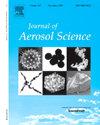Exposure of nano-sized aerosols to A549 at air liquid interface combined by condensation growth system
IF 3.9
3区 环境科学与生态学
Q2 ENGINEERING, CHEMICAL
引用次数: 0
Abstract
An accurate and stable experimental system for nano-sized aerosol cell exposure was established by controlling the number-based aerosol dose by using the Air-Liquid-Interface (ALI). In order to enhance deposition efficiency and to reduce cell damage as a novel approach, condensational growth process was employed. Two-dimensional monolayer of the alveolar epithelium (A549) cells was prepared at the ALI after 4-days cultivation using the membrane cell culture insert. Two types of test aerosol were generated by spray-drying the colloidal suspension of carbon black (CB) nanoparticles and using the solution of Triton-X100. Size distribution and aerosol number concentration were continuously monitored by in-flight aerosol mobility spectrometer. Dose amounts of nanoparticles to the A549 cell monolayer were evaluated with considering the number-based particle deposition efficiency at the ALI. The effect of condensation growth, in prior to the ALI exposure, was also investigated to enhance deposition efficiency and to mimic aerosol transport in the respiratory system. Cell viability, transepithelial electrical resistance with/without exposing the test particles were examined as a function of dose amount. It was found that constructed cellular systems exhibited stable cell viability against deposition of fine particles in our experimental condition (area-based mass dose of the CB < 2.5 μg cm−2). In addition, for Triton-X100, which was used as the positive control, a similar dose-dependent cell viability was obtained between aerosol exposure and the submerged experiments. Therefore, the constructed this exposure system could be applicable to various in vitro experiments that require precise dose control and reproducible cell responses.
求助全文
约1分钟内获得全文
求助全文
来源期刊

Journal of Aerosol Science
环境科学-工程:化工
CiteScore
8.80
自引率
8.90%
发文量
127
审稿时长
35 days
期刊介绍:
Founded in 1970, the Journal of Aerosol Science considers itself the prime vehicle for the publication of original work as well as reviews related to fundamental and applied aerosol research, as well as aerosol instrumentation. Its content is directed at scientists working in engineering disciplines, as well as physics, chemistry, and environmental sciences.
The editors welcome submissions of papers describing recent experimental, numerical, and theoretical research related to the following topics:
1. Fundamental Aerosol Science.
2. Applied Aerosol Science.
3. Instrumentation & Measurement Methods.
 求助内容:
求助内容: 应助结果提醒方式:
应助结果提醒方式:


